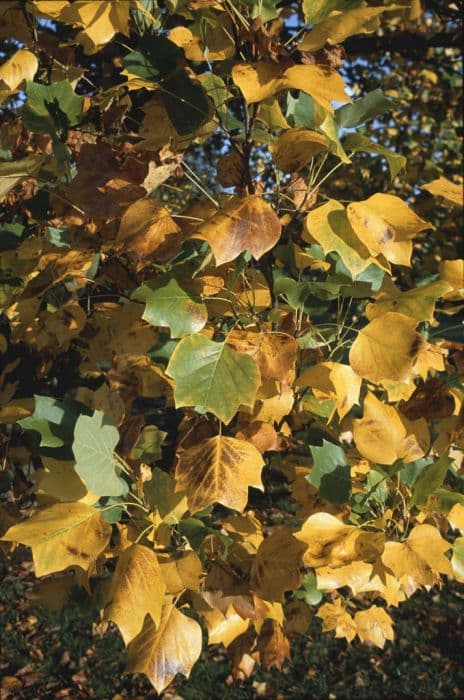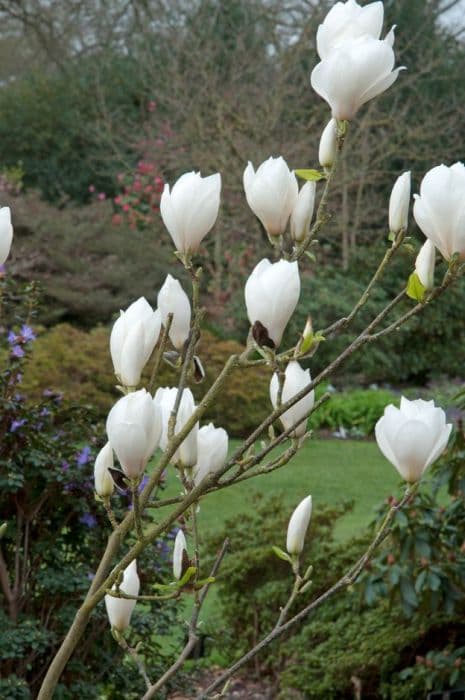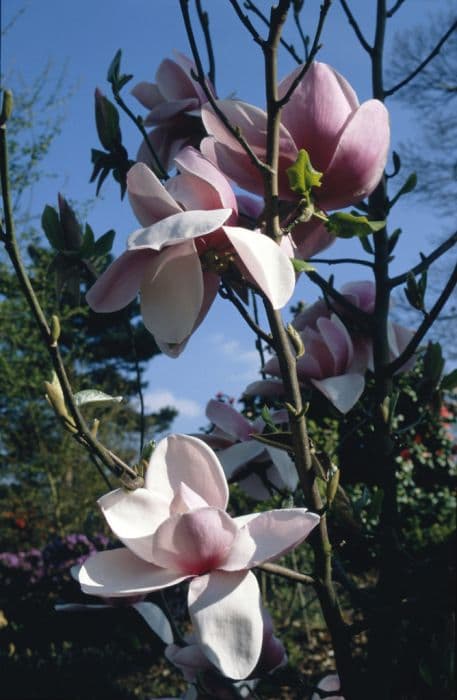Magnolia 'Galaxy' Magnolia 'Galaxy'

ABOUT
'Galaxy' is a small deciduous tree of narrowly conical outline with oval, dark green leaves and deep red-purple buds opening to flowers 20cm in width, with 12 tepals light red-purple outside, paler rose within
About this plant
 Names
NamesFamily
Magnoliaceae
Synonyms
Galaxy Magnolia
Common names
Magnolia 'Galaxy'
 Characteristics
CharacteristicsLife cycle
Perennials
Foliage type
Deciduous
Color of leaves
Green
Flower color
Pink
Height
20-30 feet (6-9 meters)
Spread
10-15 feet (3-4.5 meters)
Plant type
Tree
Hardiness zones
5
Native area
Cultivar
Benefits
 General Benefits
General Benefits- Ornamental Value: Galaxy magnolia's large, tulip-shaped purple-pink flowers add aesthetic beauty to any landscape.
- Seasonal Interest: It blooms in early spring offering a splash of color after a long winter.
- Attracts Pollinators: The flowers attract bees and other pollinators, supporting local ecosystems.
- Shade Provision: As it matures, the Galaxy magnolia provides shade in gardens and sitting areas.
- Low Maintenance: It requires minimal pruning and care once established, making it ideal for gardeners at all levels.
- Drought Tolerance: Once established, it can withstand periods of drought with less water than some other ornamental trees.
- Compact Growth: Its upright, oval growth habit makes it suitable for small to medium-sized gardens.
- Year-round Interest: Even without leaves, the tree's structure and silvery-gray bark provide visual interest in the winter landscape.
 Medical Properties
Medical PropertiesThis plant is not used for medical purposes.
 Air-purifying Qualities
Air-purifying QualitiesThis plant is not specifically known for air purifying qualities.
 Other Uses
Other Uses-
Art and Craft Projects: The petals of Magnolia 'Galaxy' can be used to create unique textures and patterns in paper making or to embellish handmade cards and scrapbooks.
-
Photography: With its stunning pink and purple blooms, Magnolia 'Galaxy' serves as an excellent subject for garden and botanical photographers looking to capture floral beauty.
-
Educational Tool: Botany students can study the structure and life cycle of Magnolia 'Galaxy' as an example of deciduous flowering trees.
-
Fabric Dye: The petals and bark of the Magnolia 'Galaxy' can be used to produce natural dyes for fabrics, offering hues of greens and browns.
-
Culinary Decoration: Edible petals of Magnolia 'Galaxy' can be candied or used fresh as a decorative and subtly flavored garnish for desserts.
-
Essential Oils: Though not a traditional source, the flowers can be distilled to create a light, floral-scented oil for perfumery and aromatherapy diffusers.
-
Cultural Symbolism: This plant can play a role in cultural events or ceremonies where flowers hold symbolic meaning, such as weddings or spring festivals.
-
Biodegradable Confetti: Dry petals of Magnolia 'Galaxy' can be used as eco-friendly confetti for outdoor celebrations which will decompose naturally.
-
Furniture Inlay: Skilled artisans could use thin slices of Magnolia 'Galaxy' wood to create intricate inlay work on fine furniture.
-
Natural Insect Repellent: Some sources suggest that the bark and leaves of Magnolia 'Galaxy' can be used to repel insects, though this is not a common practice.
-
Interesting Facts
 Feng Shui
Feng ShuiMagnolia trees are often associated with purity and nobility in Feng Shui, making them a suitable choice for enhancing the front yard to invite positive energy into the home. They can also be planted in the garden to create a calming and peaceful environment.
 Zodiac Sign Compitability
Zodiac Sign CompitabilityThe Magnolia is not used in astrology practice.
 Plant Symbolism
Plant Symbolism- Dignity: The magnolia tree is often associated with dignity due to its grand stature and impressive blooms that represent self-respect and pride.
- Persistence: Magnolias are known for their hardy nature and ability to withstand harsh conditions, symbolizing persistence and endurance.
- Feminine beauty: With their lush, large petals, magnolias are often tied to the delicate beauty and softness traditionally associated with femininity.
- Nobility: The magnolia's association with nobility stems from its frequent presence in grand and historic gardens, suggesting an air of sophistication and elegance.
- Purity: The pure white color of many magnolia flowers is emblematic of purity and innocence.
- Perseverance: Blooming in early spring, often before all other trees, magnolias symbolize perseverance and the ability to overcome life’s challenges.
 Water
WaterThe Galaxy Magnolia should be watered deeply and thoroughly, which means the soil around the roots should be soaked. During the growing season, typically in spring and summer, watering once a week is ideal. It needs about 1.5 to 2 gallons per week, depending on rainfall and soil drainage. In hot and dry periods, you may have to water twice a week, but always check the soil moisture first to avoid overwatering. During the fall and winter, reduce watering as the plant's water requirements decrease.
 Light
LightThe Galaxy Magnolia thrives best in full to partial sunlight. It should be planted in a spot where it will receive at least 4 to 6 hours of direct sunlight daily. This magnolia variety can tolerate some shade, but too much shade can lead to fewer flowers and a less robust plant.
 Temperature
TemperatureThe Galaxy Magnolia does well in a wide range of temperatures and is quite cold-hardy. It can withstand minimum winter temperatures down to about -20 degrees Fahrenheit, but the ideal growing temperatures are between 60 to 72 degrees Fahrenheit. Extreme heat above 90 degrees Fahrenheit may stress the plant, so it should be monitored and watered more frequently during such periods.
 Pruning
PruningPruning the Galaxy Magnolia should be done to remove dead or broken branches, to shape the tree, and to promote healthy growth. The best time for pruning is in late winter or early spring, before new growth starts. This plant doesn't require frequent pruning, so doing so every 2 to 3 years or as necessary to maintain its shape and remove any problematic branches is sufficient.
 Cleaning
CleaningAs needed
 Soil
SoilMagnolia 'Galaxy', or Galaxy Magnolia, thrives best in a rich, well-drained soil that is slightly acidic to neutral, with a pH range of 5.0 to 6.5. The ideal soil mix includes loamy or sandy soil amended with organic matter such as compost to ensure adequate drainage and fertility.
 Repotting
RepottingGalaxy Magnolias are typically planted outdoors and do not require frequent repotting. However, if grown in a container, young Galaxy Magnolias should be repotted every 2-3 years into a larger pot to accommodate their growing root system.
 Humidity & Misting
Humidity & MistingThe Galaxy Magnolia, commonly referred to as just Magnolia, prefers average outdoor humidity levels. While it does not require a specific humidity range, it thrives in environments that mirror its native habitat, which is moderately humid.
 Suitable locations
Suitable locationsIndoor
Place in bright light, avoid dry heat, mist leaves often.
Outdoor
Needs full sun, shelter from harsh winds, mulch roots well.
Hardiness zone
5-9 USDA
 Life cycle
Life cycleThe 'Galaxy' Magnolia begins its life cycle as a dormant seed, requiring stratification to break dormancy before germination. Upon successful germination in favorable conditions, the seedling emerges and develops into a young plant with a set of true leaves. The juvenile phase follows, where the young Magnolia 'Galaxy' experiences rapid vegetative growth and establishment. It then enters the reproductive phase, producing large, tulip-shaped, pink to purple flowers mainly in early spring, before the leaves unfurl. After pollination, it develops seed cones that mature in late summer to autumn, releasing red-coated seeds that are dispersed by wind and gravity. The mature Magnolia 'Galaxy' can live for several decades, continuously going through cycles of growth, flowering, and seed production within its lifespan.
 Propogation
PropogationPropogation time
Spring to early summer
The most popular method of propagation for the Magnolia 'Galaxy', a magnificent deciduous tree known for its striking spring blooms, is through softwood cuttings taken during the early summer when the plant's new growth is still somewhat tender but starting to firm up. To propagate, one would select a healthy portion of the tree's softwood stem that has at least two sets of leaves. The cut for the cutting should be made just below a node, which is the point on the stem where leaves are attached, because this area contains concentrated levels of growth hormones that can kickstart root development. The leaves on the lower half of the cutting should be carefully removed, and the cut end dipped into a rooting hormone powder to enhance root formation. The treated cutting is then planted in a well-draining soil mixture in a pot or tray, which should be kept consistently moist and in a warm environment with indirect sunlight. To maintain humidity, a plastic bag or cover might be placed over the setup to create a mini greenhouse effect, indirectly encouraging the cutting to establish roots, typically within a few weeks to a couple of months.









